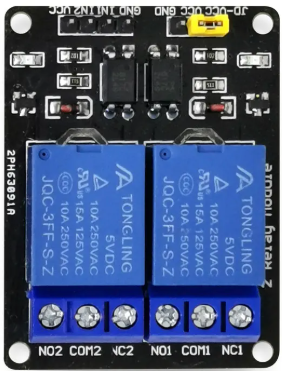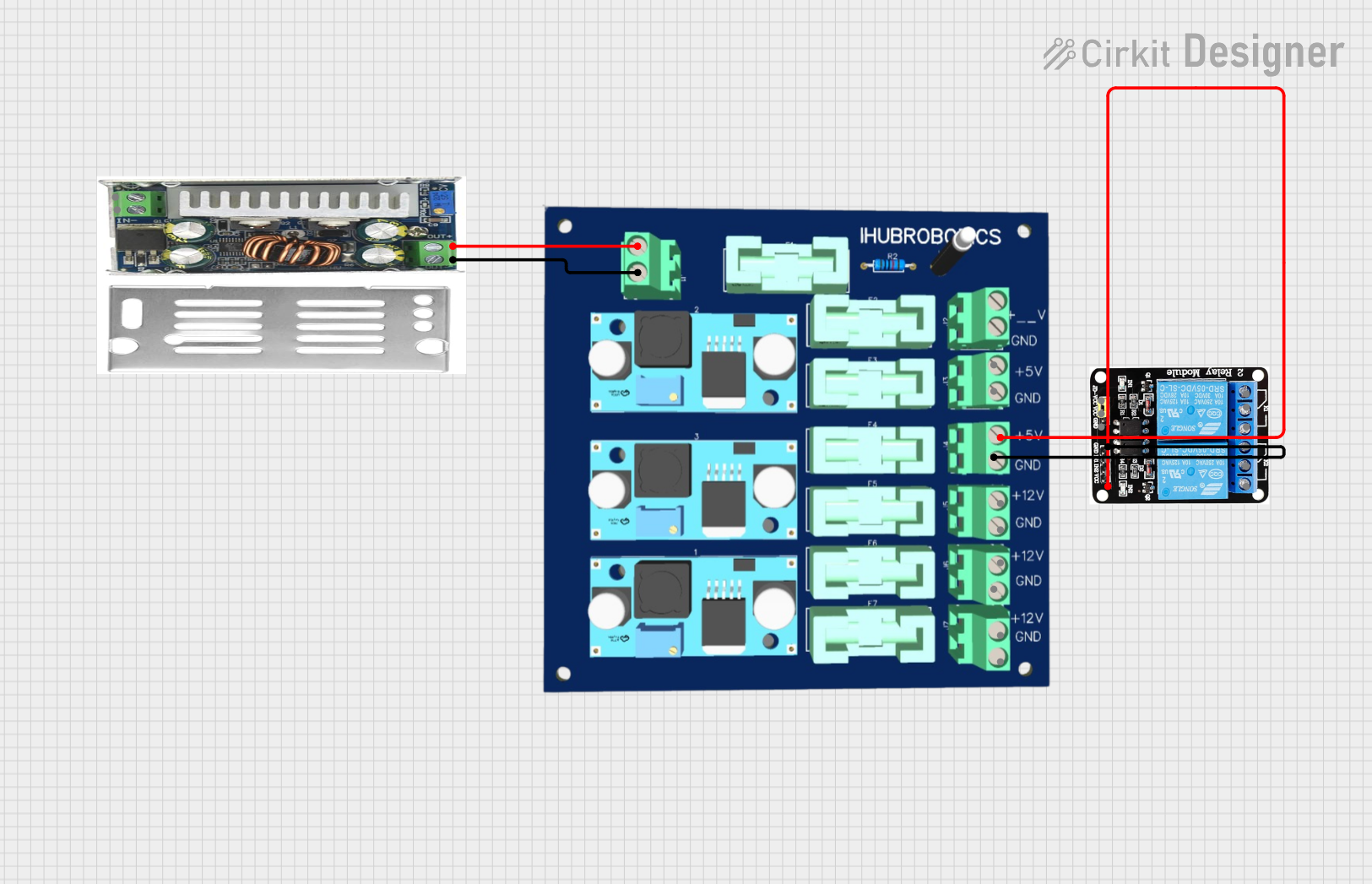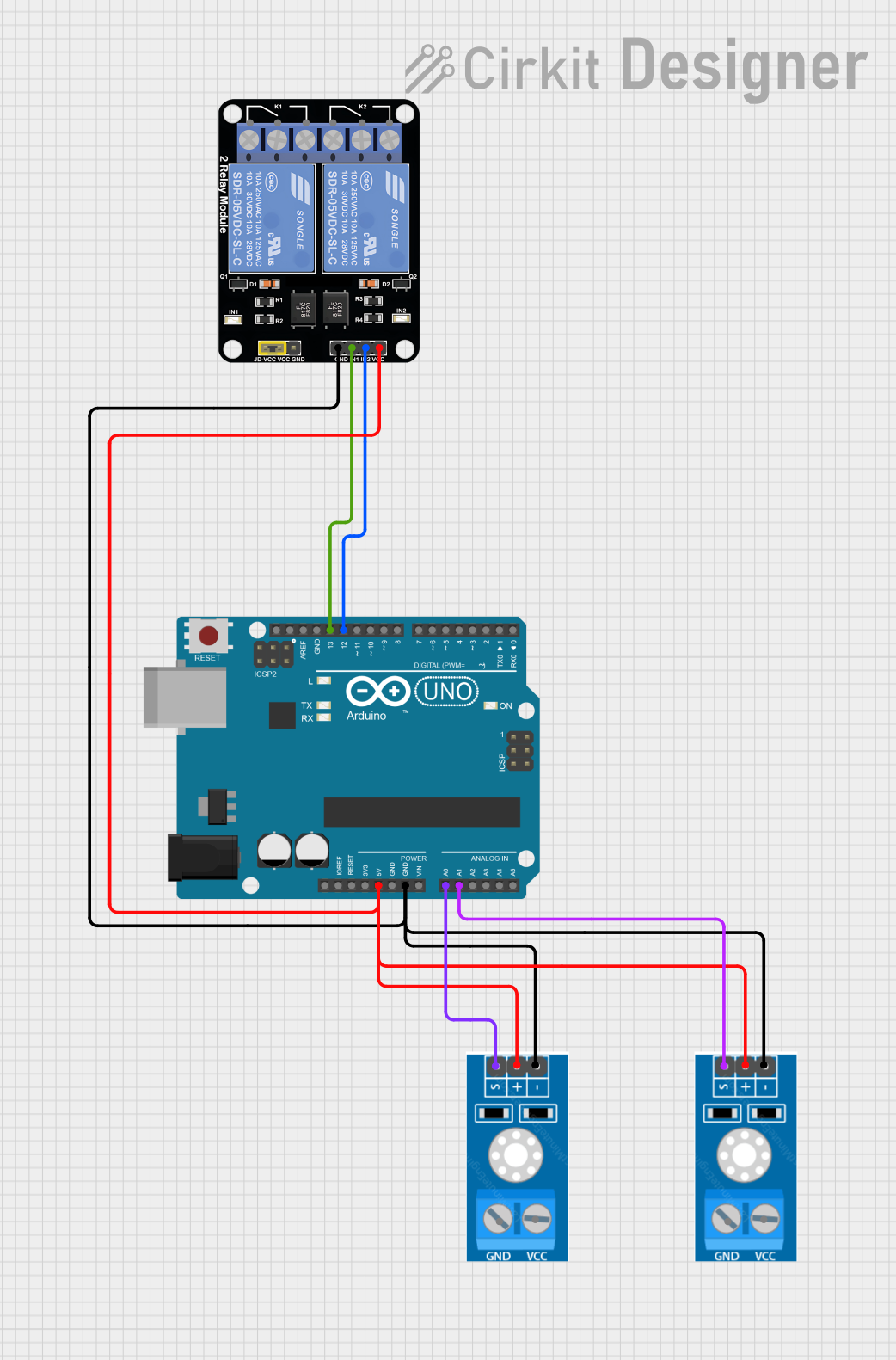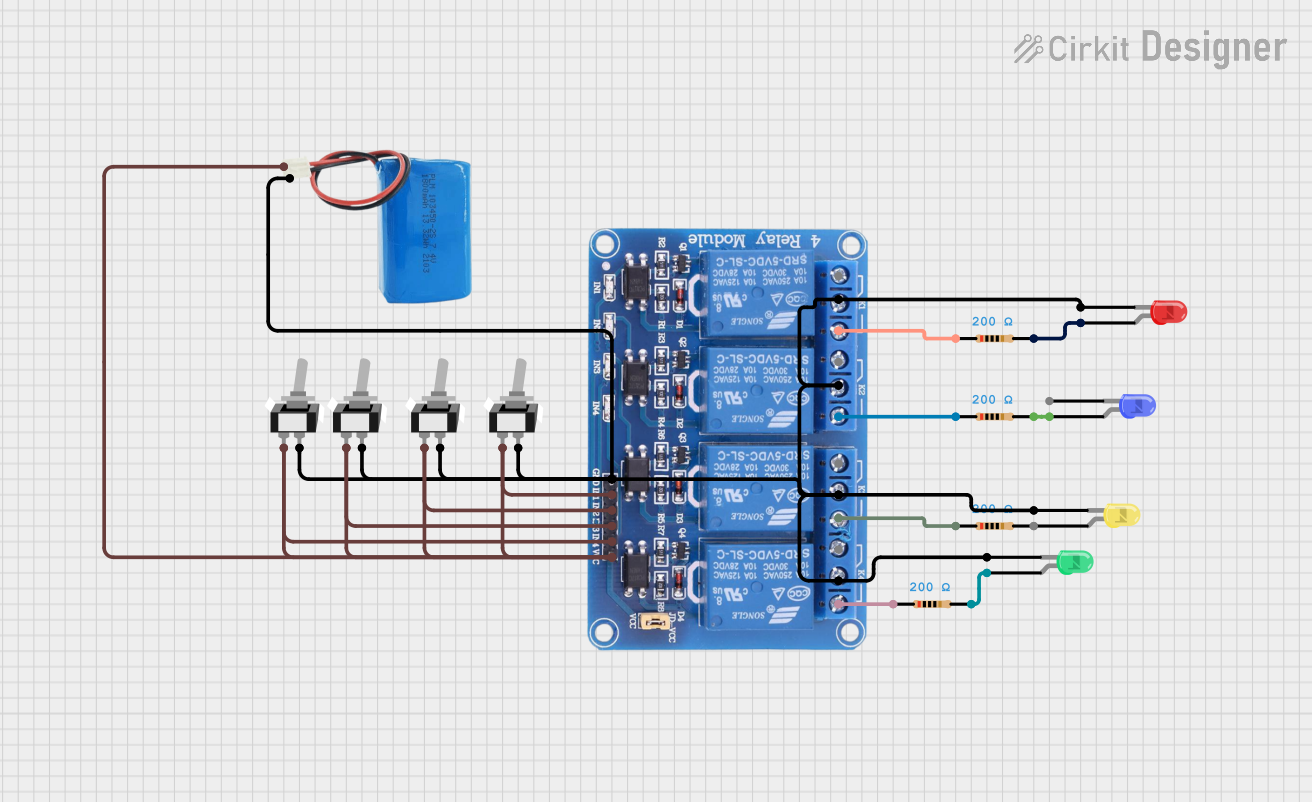
How to Use 2-channel relay module: Examples, Pinouts, and Specs

 Design with 2-channel relay module in Cirkit Designer
Design with 2-channel relay module in Cirkit DesignerIntroduction
The 2-Channel Relay Module by Michael Faraday 1830 is a versatile electronic component designed to control two independent circuits using a single microcontroller or switch. Each relay on the module acts as an electrically operated switch, allowing you to control high-voltage devices (such as lights, fans, or appliances) safely and efficiently.
This module is ideal for applications where isolation between the control circuit and the high-power circuit is required. It is commonly used in home automation, industrial control systems, and IoT projects.
Explore Projects Built with 2-channel relay module

 Open Project in Cirkit Designer
Open Project in Cirkit Designer
 Open Project in Cirkit Designer
Open Project in Cirkit Designer
 Open Project in Cirkit Designer
Open Project in Cirkit Designer
 Open Project in Cirkit Designer
Open Project in Cirkit DesignerExplore Projects Built with 2-channel relay module

 Open Project in Cirkit Designer
Open Project in Cirkit Designer
 Open Project in Cirkit Designer
Open Project in Cirkit Designer
 Open Project in Cirkit Designer
Open Project in Cirkit Designer
 Open Project in Cirkit Designer
Open Project in Cirkit DesignerCommon Applications:
- Home automation (e.g., controlling lights or appliances)
- Industrial equipment control
- IoT projects for remote device management
- Robotics and motor control
- Smart energy systems
Technical Specifications
Key Technical Details:
- Operating Voltage: 5V DC
- Trigger Voltage: 3.3V to 5V (compatible with most microcontrollers)
- Relay Type: SPDT (Single Pole Double Throw)
- Maximum Load (per relay):
- AC: 250V at 10A
- DC: 30V at 10A
- Isolation: Optocoupler isolation for safe operation
- Dimensions: 50mm x 40mm x 18mm
- Weight: ~30g
- Indicator LEDs: One LED per relay to indicate activation status
Pin Configuration and Descriptions:
The 2-channel relay module has two sets of pins: Input Pins for control signals and Relay Output Terminals for connecting the load.
Input Pins:
| Pin Name | Description |
|---|---|
| VCC | Connect to the 5V power supply (from microcontroller or external source). |
| GND | Ground connection. |
| IN1 | Control signal for Relay 1. A HIGH signal activates Relay 1. |
| IN2 | Control signal for Relay 2. A HIGH signal activates Relay 2. |
Relay Output Terminals:
Each relay has three output terminals: COM, NO, and NC.
| Terminal Name | Description |
|---|---|
| COM | Common terminal. Connect to the power source or load. |
| NO | Normally Open terminal. Connect to the load if it should be OFF by default. |
| NC | Normally Closed terminal. Connect to the load if it should be ON by default. |
Usage Instructions
How to Use the 2-Channel Relay Module in a Circuit:
Power the Module:
- Connect the VCC pin to a 5V power source and the GND pin to ground.
- Ensure the power supply can provide sufficient current for the relays (typically ~70mA per relay when active).
Connect the Control Signals:
- Connect the IN1 and IN2 pins to the digital output pins of a microcontroller (e.g., Arduino UNO).
- When the microcontroller sends a HIGH signal to IN1 or IN2, the corresponding relay will activate.
Connect the Load:
- Identify whether the load should be connected to the NO (Normally Open) or NC (Normally Closed) terminal.
- Connect the power source for the load to the COM terminal.
- Connect the load to either the NO or NC terminal, depending on the desired default state.
Test the Circuit:
- Power on the system and send control signals to the IN1 and IN2 pins to toggle the relays.
- Verify that the connected loads are switching as expected.
Important Considerations and Best Practices:
- Isolation: The module uses optocouplers for isolation, but ensure proper grounding between the control and load circuits.
- Load Ratings: Do not exceed the maximum voltage or current ratings of the relays.
- Flyback Diodes: For inductive loads (e.g., motors), use flyback diodes to protect the relays from voltage spikes.
- Safety: Always disconnect power before wiring high-voltage loads to the relay module.
Example: Connecting to an Arduino UNO
Below is an example of how to control the 2-channel relay module using an Arduino UNO:
Circuit Connections:
- VCC → Arduino 5V
- GND → Arduino GND
- IN1 → Arduino Digital Pin 7
- IN2 → Arduino Digital Pin 8
- Connect a 220V AC lamp to Relay 1 (COM and NO terminals).
Arduino Code:
// Define the relay control pins
const int relay1 = 7; // Relay 1 control pin
const int relay2 = 8; // Relay 2 control pin
void setup() {
// Set relay pins as outputs
pinMode(relay1, OUTPUT);
pinMode(relay2, OUTPUT);
// Initialize relays to OFF state
digitalWrite(relay1, LOW);
digitalWrite(relay2, LOW);
}
void loop() {
// Turn Relay 1 ON for 2 seconds
digitalWrite(relay1, HIGH); // Activate Relay 1
delay(2000); // Wait for 2 seconds
// Turn Relay 1 OFF
digitalWrite(relay1, LOW); // Deactivate Relay 1
delay(1000); // Wait for 1 second
// Turn Relay 2 ON for 3 seconds
digitalWrite(relay2, HIGH); // Activate Relay 2
delay(3000); // Wait for 3 seconds
// Turn Relay 2 OFF
digitalWrite(relay2, LOW); // Deactivate Relay 2
delay(1000); // Wait for 1 second
}
Troubleshooting and FAQs
Common Issues:
Relays Not Activating:
- Cause: Insufficient power supply or incorrect wiring.
- Solution: Ensure the module is powered with 5V and the control signals are HIGH.
Load Not Switching:
- Cause: Incorrect connection to the relay terminals.
- Solution: Verify the load is connected to the correct terminals (COM, NO, or NC).
Microcontroller Resetting:
- Cause: Relays drawing too much current, causing voltage drops.
- Solution: Use an external power supply for the relay module.
Relay Clicking Noise:
- Cause: Rapid switching of the control signal.
- Solution: Add a delay in the control code to prevent rapid toggling.
FAQs:
Q: Can I use this module with a 3.3V microcontroller?
A: Yes, the module is compatible with 3.3V control signals, but ensure the relays are powered with 5V.Q: Can I control DC motors with this module?
A: Yes, but use flyback diodes to protect the relays from voltage spikes caused by the motors.Q: Is the module safe for high-voltage applications?
A: Yes, but always follow proper safety precautions when working with high voltages.
This concludes the documentation for the 2-Channel Relay Module by Michael Faraday 1830.